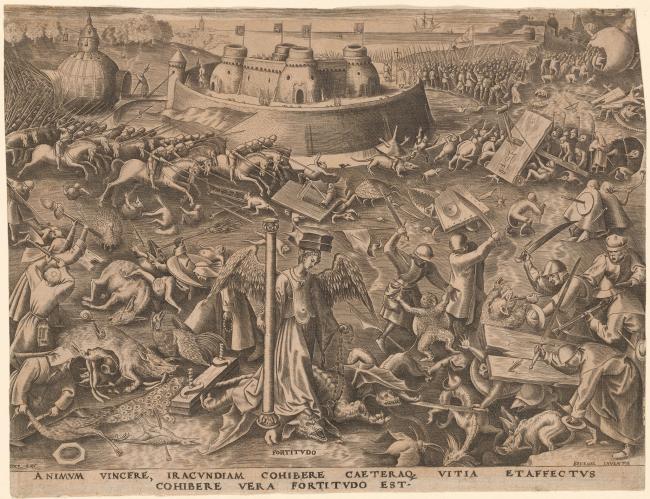
Philippe Galle
1537-1612
Fortitude, after Pieter Bruegel the Elder
ca. 1560
Engraving on paper.
22.1 x 28.4 cm (8 3/4 x 11 3 1/6 in.)
Gift of William M. Voelkle.
2006.83
Notes
Watermark: very similar to several double-tiered crowns in Briquet, vol. 2, nos. 4950-4959, all of which locate the paper to various regions in Europe during the first half of the sixteenth century.
This image is part of a series of the Seven Virtues, a suite of drawings that Bruegel began in 1559, a year after he completed his series of the Seven Deadly Sins. The preliminary drawing for Fortitude (Museum Boijmans Van Beuningen, Rotterdam) is signed and dated 1560. This print is from the first state for the engraving, which was executed after Bruegel's drawing by the renowned printmaker Philips Galle (L. Lebeer, Catalogue raisonn ̌des estampes de Bruegel l'ancien. Brussels, 1969, pp. 101-104, no. 36) and then published by Hieronymous Cock, whose name appears in the lower left corner of the composition. Cock and Bruegel had a long-standing working relationship, and Cock may have introduced the artist to printmaking (T. Riggs, Hieronymous Cock: Printmaker and Publisher. New York, 1977, p. 59). Cock's employment of Galle to engrave Bruegel's designs for the Seven Virtues resulted in the creation of some of the finest engravings made in sixteenth-century Antwerp (M. Sellink in Bruegel the Elder: Drawings and Prints, p. 192). A rare early impression of Fortitude can also be found at the Museum Boijmans Van Beuningen in Rotterdam (BdH 15044).
While we cannot be certain exactly when the Morgan's version was printed, its watermark suggests that the paper dates to the first half of early sixteenth century and comes from either northern Europe or Italy. It is possible that our example is relatively early and may have been printed during Bruegel's lifetime.
Fortitude was one of the qualities that the Catholic Church determined were necessary for a devout Christian to gain entry into heaven. In this engraving, Bruegel has depicted the allegorical figure of Fortitude as conquering the dragon of material desires, while around her, in front of the castle representing faith, forces of good overcome their evil opponents (Prints and Drawings of Pieter Bruegel the Elder, p. 40, no. 55). The inscription, added to the margin of the engraving plate by a later hand, states "to conquer one's impulses, to restrain anger and the other vices and emotions: this is the true fortitude." (Andaleeb Banta)
This image is part of a series of the Seven Virtues, a suite of drawings that Bruegel began in 1559, a year after he completed his series of the Seven Deadly Sins. The preliminary drawing for Fortitude (Museum Boijmans Van Beuningen, Rotterdam) is signed and dated 1560. This print is from the first state for the engraving, which was executed after Bruegel's drawing by the renowned printmaker Philips Galle (L. Lebeer, Catalogue raisonn ̌des estampes de Bruegel l'ancien. Brussels, 1969, pp. 101-104, no. 36) and then published by Hieronymous Cock, whose name appears in the lower left corner of the composition. Cock and Bruegel had a long-standing working relationship, and Cock may have introduced the artist to printmaking (T. Riggs, Hieronymous Cock: Printmaker and Publisher. New York, 1977, p. 59). Cock's employment of Galle to engrave Bruegel's designs for the Seven Virtues resulted in the creation of some of the finest engravings made in sixteenth-century Antwerp (M. Sellink in Bruegel the Elder: Drawings and Prints, p. 192). A rare early impression of Fortitude can also be found at the Museum Boijmans Van Beuningen in Rotterdam (BdH 15044).
While we cannot be certain exactly when the Morgan's version was printed, its watermark suggests that the paper dates to the first half of early sixteenth century and comes from either northern Europe or Italy. It is possible that our example is relatively early and may have been printed during Bruegel's lifetime.
Fortitude was one of the qualities that the Catholic Church determined were necessary for a devout Christian to gain entry into heaven. In this engraving, Bruegel has depicted the allegorical figure of Fortitude as conquering the dragon of material desires, while around her, in front of the castle representing faith, forces of good overcome their evil opponents (Prints and Drawings of Pieter Bruegel the Elder, p. 40, no. 55). The inscription, added to the margin of the engraving plate by a later hand, states "to conquer one's impulses, to restrain anger and the other vices and emotions: this is the true fortitude." (Andaleeb Banta)
Inscriptions/Markings
Inscribed, at lower left above margin, COCK EXC; at lower center, above margin FORTITVDO; at lower right, above margin, BRVEGEL INVENTOR; across bottom, in margin ANIMVM VINCERE, IRACVNDIAM COHIBERE CAETERAQ VITIA ETAFFECTVS / COHIBERE VERA FORTITVDO ESTʺ; on verso, lower center in graphite, 40 --- ; in another hand in graphite, Bastelaer 137; lower left, stamp of British Museum "1866" (Lugt 302) and British Museum duplicate (Lugt 305) with CD. written in pen and ink inside stamp; lower center, in graphite, v. Bast 137
Provenance
British Museum, London (Lugt 302 and 305), by 1866; William M. Voelkle, New York, until 2006.
Associated names
Voelkle, William M., former owner.
Bibliography
R. v. Bastelaer, Les estampes de Peter Brugel L'Ancien. Brussels, 1908, no. 137.<br>Prints and Drawings of Pieter Bruegel the Elder Exhibition. Los Angeles, 1961, no. 55.<br>A. Dolders, Netherlandish Artists: Philips Galle. The Illustrated Bartsch, vol. 56. New York, 1987, no. 070:6.<br>N. Orenstein, ed. Pieter Bruegel the Elder: Drawings and Prints. New York, 2001, no. 75.
Artist
Classification
Department
Century prints
School
Catalog link
